Multicomponent Synthesis of New Fluorescent Boron Complexes Derived from 3-Hydroxy-1-phenyl-1H-pyrazole-4-carbaldehyde
Abstract
1. Introduction
2. Results and Discussion
2.1. Chemistry
2.2. NMR Spectroscopic Investigations
2.3. Single-Crystal X-ray Diffraction Analysis
2.4. Optical Investigations
3. Materials and Methods
3.1. General
3.2. Synthetic Procedures
4. Conclusions
Supplementary Materials
Author Contributions
Funding
Institutional Review Board Statement
Informed Consent Statement
Data Availability Statement
Conflicts of Interest
References
- Heravi, M.M.; Zadsirjana, V. Prescribed drugs containing nitrogen heterocycles: An overview. RSC Adv. 2020, 10, 44247–44311. [Google Scholar] [CrossRef] [PubMed]
- Wu, Y.-J. Heterocycles and Medicine: A Survey of the Heterocyclic Drugs Approved by the U.S. FDA from 2000 to Present. In Progress in Heterocyclic Chemistry, 1st ed.; Gribble, G.W., Joule, A.J., Eds.; Elsevier: Amsterdam, The Netherlands, 2012; Volume 24, pp. 1–53. [Google Scholar]
- Lamberth, C. Heterocyclic chemistry in crop protection. Pest Manag. Sci. 2013, 69, 1106–1114. [Google Scholar] [CrossRef]
- Jeschke, P. Recent developments in fluorine-containing pesticides. Pest Manag. Sci. 2024, 80, 3065–3087. [Google Scholar] [CrossRef] [PubMed]
- Iftikhar, R.; Khan, F.Z.; Naeem, N. Recent synthetic strategies of small heterocyclic organic molecules with optoelectronic applications: A review. Mol. Divers. 2024, 28, 271–307. [Google Scholar] [CrossRef] [PubMed]
- Torres-Méndez, C.; Axelsson, M.; Tian, H. Small Organic Molecular Electrocatalysts for Fuels Production. Angew. Chem. Int. Ed. 2024, 63, e202312879. [Google Scholar] [CrossRef] [PubMed]
- Bastos, I.M.; Rebelo, S.; Silva, V.L.M. A review of poly(ADP-ribose)polymerase-1 (PARP1) role and its inhibitors bearing pyrazole or indazole core for cancer therapy. Biochem. Pharmacol. 2024, 221, 116045. [Google Scholar] [CrossRef]
- Xu, Z.; Zhuang, Y.; Chen, Q. Current scenario of pyrazole hybrids with in vivo therapeutic potential against cancers. Eur. J. Med. Chem. 2023, 257, 115495. [Google Scholar] [CrossRef]
- Basha, N.J. Small Molecules as Anti-inflammatory Agents: Molecular Mechanisms and Heterocycles as Inhibitors of Signaling Pathways. ChemistrySelect 2023, 8, e202204723. [Google Scholar] [CrossRef]
- Toulis, K.A.; Nirantharakumar, K.; Pourzitaki, C.; Barnett, A.H.; Tahrani, A.A. Glucokinase Activators for Type 2 Diabetes: Challenges and Future Developments. Drugs 2020, 80, 467–475. [Google Scholar] [CrossRef]
- McCormack, P.L. Celecoxib. Drugs 2011, 71, 2457–2489. [Google Scholar] [CrossRef] [PubMed]
- Lindsley, C.W.; Wisnoski, D.D.; Leister, W.H.; O’Brien, J.A.; Lemaire, W.; Williams, D.L.; Burno, M.; Sur, C.; Kinney, G.G.; Pettibone, D.J.; et al. Discovery of Positive Allosteric Modulators for the Metabotropic Glutamate Receptor Subtype 5 from a Series of N-(1,3-Diphenyl-1H-pyrazol-5-yl)benzamides That Potentiate Receptor Function In Vivo. J. Med. Chem. 2004, 47, 5825–5828. [Google Scholar] [CrossRef] [PubMed]
- Barth, F.; Rinaldi-Carmona, M. The Development of Cannabinoid Antagonists. Curr. Med. Chem. 1999, 6, 745–755. [Google Scholar] [CrossRef] [PubMed]
- Secci, D.; Bolasco, A.; Chimenti, P.; Carradori, S. The State of the Art of Pyrazole Derivatives as Monoamine Oxidase Inhibitors and Antidepressant/Anticonvulsant Agents. Curr. Med. Chem. 2011, 18, 5114–5144. [Google Scholar] [CrossRef] [PubMed]
- Huang, D.; Liu, F.; Wen, S.; Wang, Y.; Fang, W.; Zhang, Z.; Ke, S. Substituted pyrazole derivatives as potential fungicidal agents. Phytochem. Lett. 2024, 59, 117–123. [Google Scholar] [CrossRef]
- Khallaf, A.; Wang, P.; Zhuo, S.P.; Zhu, H.J.; Liu, H. Synthesis, insecticidal activities, and structure-activity relationships of 1,3,4-oxadiazole-ring-containing pyridylpyrazole-4-carboxamides as novel insecticides of the anthranilic diamide family. J. Heterocycl. Chem. 2021, 58, 2189–2202. [Google Scholar] [CrossRef]
- Mykhailiuk, P.K. Fluorinated Pyrazoles: From Synthesis to Applications. Chem. Rev. 2021, 121, 1670–1715. [Google Scholar] [CrossRef] [PubMed]
- Tigrerosa, A.; Portilla, J. Recent progress in chemosensors based on pyrazole derivatives. RSC Adv. 2020, 10, 19693–19712. [Google Scholar] [CrossRef] [PubMed]
- Tigreros, A.; Portilla, J. Fluorescent Pyrazole Derivatives: An Attractive Scaffold for Biological Imaging Applications. Curr. Chin. Sci. 2021, 1, 197–206. [Google Scholar] [CrossRef]
- Parshad, M.; Kumar, D.; Verma, V. A mini review on applications of pyrazole ligands in coordination compounds and metal organic frameworks. Inorganica Chim. Acta 2024, 560, 121789. [Google Scholar] [CrossRef]
- Ebenezer, O.; Shapi, M.; Tuszynski, J.A. A Review of the Recent Development in the Synthesis and Biological Evaluations of Pyrazole Derivatives. Biomedicines 2022, 10, 1124. [Google Scholar] [CrossRef] [PubMed]
- Jain, S. Epigrammatic Review on Heterocyclic Moiety Pyrazole: Applications and Synthesis Routes. Mini-Rev. Org. Chem. 2024, 21, 684–702. [Google Scholar] [CrossRef]
- Kang, E.; Kim, H.T.; Joo, J.M. Transition-metal-catalyzed C–H functionalization of pyrazoles. Org. Biomol. Chem. 2020, 18, 6192–6210. [Google Scholar] [CrossRef] [PubMed]
- Liu, L.; Durai, M.; Doucet, H. Transition Metal-Catalyzed Regiodivergent C−H Arylations of Aryl-Substituted Azoles. Eur. J. Org. Chem. 2022, 2022, e202200007. [Google Scholar] [CrossRef]
- Becerra, D.; Abonia, R.; Castillo, J.-C. Recent Applications of the Multicomponent Synthesis for Bioactive Pyrazole Derivatives. Molecules 2022, 27, 4723. [Google Scholar] [CrossRef] [PubMed]
- Medjahed, N.; Kibou, Z.; Berrichi, A.; Choukchou-Braham, N. Advances in Pyrazoles Rings’ Syntheses by Heterogeneous Catalysts, Ionic Liquids, and Multicomponent Reactions—A Review. Curr. Org. Chem. 2023, 27, 471–509. [Google Scholar] [CrossRef]
- Banfi, L.; Lambruschini, C. 100 years of isocyanide-based multicomponent reactions. Mol. Divers. 2024, 28, 1–2. [Google Scholar] [CrossRef] [PubMed]
- Damera, T.; Pagadala, R.; Rana, S.; Jonnalagadda, S.B. A Concise Review of Multicomponent Reactions Using Novel Heterogeneous Catalysts under Microwave Irradiation. Catalysts 2023, 13, 1034. [Google Scholar] [CrossRef]
- Banerjee, R.; Ali, D.; Mondal, N.; Choudhury, L.H. HFIP-Mediated Multicomponent Reactions: Synthesis of Pyrazole-Linked Thiazole Derivatives. J. Org. Chem. 2024, 89, 4423–4437. [Google Scholar] [CrossRef] [PubMed]
- Méndez, Y.; Vasco, A.V.; Ivey, G.; Dias, A.L.; Gierth, P.; Sousa, B.B.; Navo, C.D.; Torres-Mozas, A.; Rodrigues, T.; Jiménez-Osés, G.; et al. Merging the Isonitrile-Tetrazine (4 + 1) Cycloaddition and the Ugi Four-Component Reaction into a Single Multicomponent Process. Angew. Chem. Int. Ed. 2023, 62, e202311186. [Google Scholar] [CrossRef] [PubMed]
- Pearce, A.J.; Harkins, R.P.; Reiner, B.R.; Wotal, A.C.; Dunscomb, R.J.; Tonks, I.A. Multicomponent Pyrazole Synthesis from Alkynes, Nitriles, and Titanium Imido Complexes via Oxidatively Induced N–N Bond Coupling. J. Am. Chem. Soc. 2020, 142, 4390–4399. [Google Scholar] [CrossRef]
- Savickienė, V.; Bieliauskas, A.; Belyakov, S.; Šačkus, A.; Arbačiauskienė, E. Synthesis and characterization of novel biheterocyclic compounds from 3-alkoxy-1H-pyrazole-4-carbaldehydes via multicomponent reactions. J. Heterocycl. Chem. 2024, 61, 927–947. [Google Scholar] [CrossRef]
- Mahanta, C.S.; Ravichandiran, V.; Swain, S.P. Recent Developments in the Design of New Water-Soluble Boron Dipyrromethenes and Their Applications: An Updated Review. ACS Appl. Bio Mater. 2023, 6, 2995–3018. [Google Scholar] [CrossRef] [PubMed]
- Kaur, M.; Janaagal, A.; Balsukuri, N.; Gupta, I. Evolution of Aza-BODIPY dyes-A hot topic. Coord. Chem. Rev. 2024, 498, 215428. [Google Scholar] [CrossRef]
- Yuan, L.; Su, Y.; Cong, H.; Yu, B.; Shen, Y. Application of multifunctional small molecule fluorescent probe BODIPY in life science. Dye. Pigment. 2022, 208, 110851. [Google Scholar] [CrossRef]
- Ilhan, H.; Cakmak, Y. Functionalization of BODIPY Dyes with Additional C–N Double Bonds and Their Applications. Top. Curr. Chem. 2023, 381, 28. [Google Scholar] [CrossRef] [PubMed]
- Wang, S.; Gai, L.; Chen, Y.; Ji, X.; Lu, H.; Guo, Z. Mitochondria-targeted BODIPY dyes for small molecule recognition, bio-imaging and photodynamic therapy. Chem. Soc. Rev. 2024, 53, 3976–4019. [Google Scholar] [CrossRef] [PubMed]
- Chen, Z.; Chen, Y.; Xu, Y.; Shi, X.; Han, Z.; Bai, Y.; Fang, H.; He, W.; Guo, Z. BODIPY-Based Multifunctional Nanoparticles for Dual Mode Imaging-Guided Tumor Photothermal and Photodynamic Therapy. ACS Appl. Bio Mater. 2023, 6, 3406–3413. [Google Scholar] [CrossRef]
- Cao, N.; Jiang, Y.; Song, Z.-B.; Chen, D.; Wu, D.; Chen, Z.-L.; Yan, Y.-J. Synthesis and evaluation of novel meso-substitutedphenyl dithieno[3,2-b]thiophene-fused BODIPY derivatives as efficient photosensitizers for photodynamic therapy. Eur. J. Med. Chem. 2024, 264, 116012. [Google Scholar] [CrossRef]
- Wang, J.; Gong, Q.; Jiao, L.; Hao, E. Research advances in BODIPY-assembled supramolecular photosensitizers for photodynamic therapy. Coord. Chem. Rev. 2023, 496, 215367. [Google Scholar] [CrossRef]
- Yadava, I.S.; Misra, R. Design, synthesis and functionalization of BODIPY dyes: Applications in dye-sensitized solar cells (DSSCs) and photodynamic therapy (PDT). J. Mater. Chem. C Mater. Opt. Electron. Devices 2023, 11, 8688–8723. [Google Scholar] [CrossRef]
- Bumagina, N.A.; Antina, E.V. Review of advances in development of fluorescent BODIPY probes (chemosensors and chemodosimeters) for cation recognition. Coord. Chem. Rev. 2024, 505, 215688. [Google Scholar] [CrossRef]
- Kursunlu, A.N.; Bastug, E.; Guler, E. Importance of BODIPY-based Chemosensors for Cations and Anions in Bio-imaging Applications. Curr. Anal. Chem. 2022, 18, 163–175. [Google Scholar] [CrossRef]
- Alcaide, M.M.; Santos, F.M.F.; Pais, V.F.; Carvalho, J.I.; Collado, D.; Pérez-Inestrosa, E.; Arteaga, J.F.; Boscá, F.; Gois, P.M.P.; Pischel, U. Electronic and Functional Scope of Boronic Acid Derived Salicylidenehydrazone (BASHY) Complexes as Fluorescent Dyes. J. Org. Chem. 2017, 82, 7151–7158. [Google Scholar] [CrossRef] [PubMed]
- Guieu, S.; Esteves, C.I.C.; Rocha, J.; Silva, A.M.S. Multicomponent Synthesis of Luminescent Iminoboronates. Molecules 2020, 25, 6039. [Google Scholar] [CrossRef] [PubMed]
- Santos, F.M.F.; Rosa, J.N.; Candeias, N.R.; Carvalho, C.P.; Matos, A.I.; Ventura, A.E.; Florindo, H.F.; Silva, L.C.; Pischel, U.; Gois, P.M.P. A Three-Component Assembly Promoted by Boronic Acids Delivers a Modular Fluorophore Platform (BASHY Dyes). Chem. Eur. J. 2016, 22, 1631. [Google Scholar] [CrossRef]
- García-López, M.C.; Herrera-España, A.D.; Estupiñan-Jiménez, J.R.; González-Villasana, V.; Cáceres-Castillo, D.; Bojórquez-Quintal, E.; Elizondo, P.; Jiménez-Barrera, R.M.; Chan-Navarro, R. New luminescent organoboron esters based on damnacanthal: One-pot multicomponent synthesis, optical behavior, cytotoxicity, and selectivity studies against MDA-MBA-231 breast cancer cells. N. J. Chem. 2022, 46, 20138–20145. [Google Scholar] [CrossRef]
- Cáceres-Castillo, D.; Mirón-López, G.; García-López, M.C.; Chan-Navarro, R.; Quijano-Quiñones, R.F.; Briceño-Vargas, F.M.; Cauich-Kumul, R.; Morales-Rojas, H.; Herrera-España, A.D. Boronate derivatives of damnacanthal: Synthesis, characterization, optical properties and theoretical calculations. J. Mol. Struct. 2023, 1271, 134048. [Google Scholar] [CrossRef]
- Adib, M.; Sheikhi, E.; Bijanzadeh, H.R.; Zhu, L.-G. Microwave-assisted reaction between 2-aminobenzoic acids, 2-hydroxybenzaldehydes, and arylboronic acids: A one-pot three-component synthesis of bridgehead bicyclo[4.4.0]boron heterocycles. Tetrahedron 2012, 68, 3377–3383. [Google Scholar] [CrossRef]
- Montalbano, F.; Cal, P.M.S.D.; Carvalho, M.A.B.R.; Gonçalves, L.M.; Lucas, S.D.; Guedes, R.C.; Veiros, L.F.; Moreira, R.; Gois, P.M.P. Discovery of new heterocycles with activity against human neutrophile elastase based on a boron promoted one-pot assembly reaction. Org. Biomol. Chem. 2013, 11, 4465–4472. [Google Scholar] [CrossRef] [PubMed]
- Cal, P.M.S.D.; Sieglitz, F.; Santos, F.M.F.; Carvalho, C.P.; Guerreiro, A.; Bertoldo, J.B.; Pischel, U.; Gois, P.M.P.; Bernardes, G.J.L. Site-selective installation of BASHY fluorescent dyes to Annexin V for targeted detection of apoptotic cells. Chem. Commun. 2017, 53, 368–371. [Google Scholar] [CrossRef]
- Zagorskytė, I.; Bieliauskas, A.; Pukalskienė, M.; Rollin, P.; Arbačiauskienė, E.; Šačkus, A. Glycerol-1,2-carbonate: A mild reagent for the N-glycerylation of pyrazolecarboxylates. J. Heterocycl. Chem. 2024, 61, 305–323. [Google Scholar] [CrossRef]
- Urbonavičius, A.; Krikštolaitytė, S.; Bieliauskas, A.; Martynaitis, V.; Solovjova, J.; Žukauskaitė, A.; Arbačiauskienė, E.; Šačkus, A. Synthesis and Characterization of New Pyrano[2,3-c]pyrazole Derivatives as 3-Hydroxyflavone Analogues. Molecules 2023, 28, 6599. [Google Scholar] [CrossRef] [PubMed]
- Dzedulionytė, K.; Fuxreiter, N.; Schreiber-Brynzak, E.; Žukauskaitė, A.; Šačkus, A.; Pichler, V.; Arbačiauskienė, E. Pyrazole-based lamellarin O analogues: Synthesis, biological evaluation and structure–activity relationships. RSC Adv. 2023, 13, 7897–7912. [Google Scholar] [CrossRef] [PubMed]
- Varvuolytė, G.; Malina, L.; Bieliauskas, A.; Hošíková, B.; Simerská, H.; Kolářová, H.; Kleizienė, N.; Kryštof, V.; Šačkus, A.; Žukauskaitė, A. Synthesis and photodynamic properties of pyrazole-indole hybrids in the human skin melanoma cell line G361. Dye. Pigment. 2020, 183, 108666. [Google Scholar] [CrossRef]
- Razmienė, B.; Vojáčková, V.; Řezníčková, E.; Malina, L.; Dambrauskienė, V.; Kubala, M.; Bajgar, R.; Kolářová, H.; Žukauskaitė, A.; Arbačiauskienė, E.; et al. Synthesis of N-aryl-2,6-diphenyl-2H-pyrazolo[4,3-c]pyridin-7-amines and their photodynamic properties in the human skin melanoma cell line G361. Bioorganic Chem. 2022, 119, 105570. [Google Scholar] [CrossRef] [PubMed]
- Milišiūnaitė, V.; Kadlecová, A.; Žukauskaitė, A.; Doležal, K.; Strnad, M.; Voller, J.; Arbačiauskienė, E.; Holzer, W.; Šačkus, A. Synthesis and anthelmintic activity of benzopyrano[2,3-c]pyrazol-4(2H)-one derivatives. Mol. Divers. 2020, 24, 1025–1042. [Google Scholar] [CrossRef] [PubMed]
- Arbačiauskienė, E.; Martynaitis, V.; Krikštolaitytė, S.; Holzer, W.; Šačkus, A. Synthesis of 3-substituted 1-phenyl-1H-pyrazole-4-carbaldehydes and the corresponding ethanones by Pd-catalysed cross-coupling reactions. Arkivoc 2011, 11, 1–21. [Google Scholar] [CrossRef]
- Suman, G.R.; Pandey, M.; Chakravarthy, A.S.J. Review on new horizons of aggregation induced emission: From design to development. Mater. Chem. Front. 2021, 5, 1541–1584. [Google Scholar]
- Braun, S.; Kalinowski, H.-O.; Berger, S. 150 and More Basic NMR Experiments: A Practical Course, 2nd ed.; ACS: New York, NY, USA, 2000. [Google Scholar]
- Buevich, A.V.; Williamson, R.T.; Martin, G.E. NMR Structure Elucidation of Small Organic Molecules and Natural Products: Choosing ADEQUATE vs HMBC. J. Nat. Prod. 2014, 77, 1942–1947. [Google Scholar] [CrossRef] [PubMed]
- Sheldrick, G.M. A short history of SHELX. Acta Cryst. 2008, A64, 112–122. [Google Scholar] [CrossRef] [PubMed]
- Shedrick, G.M. Crystal structure refinement with SHELXL. Acta Cryst. 2015, C71, 3–8. [Google Scholar]
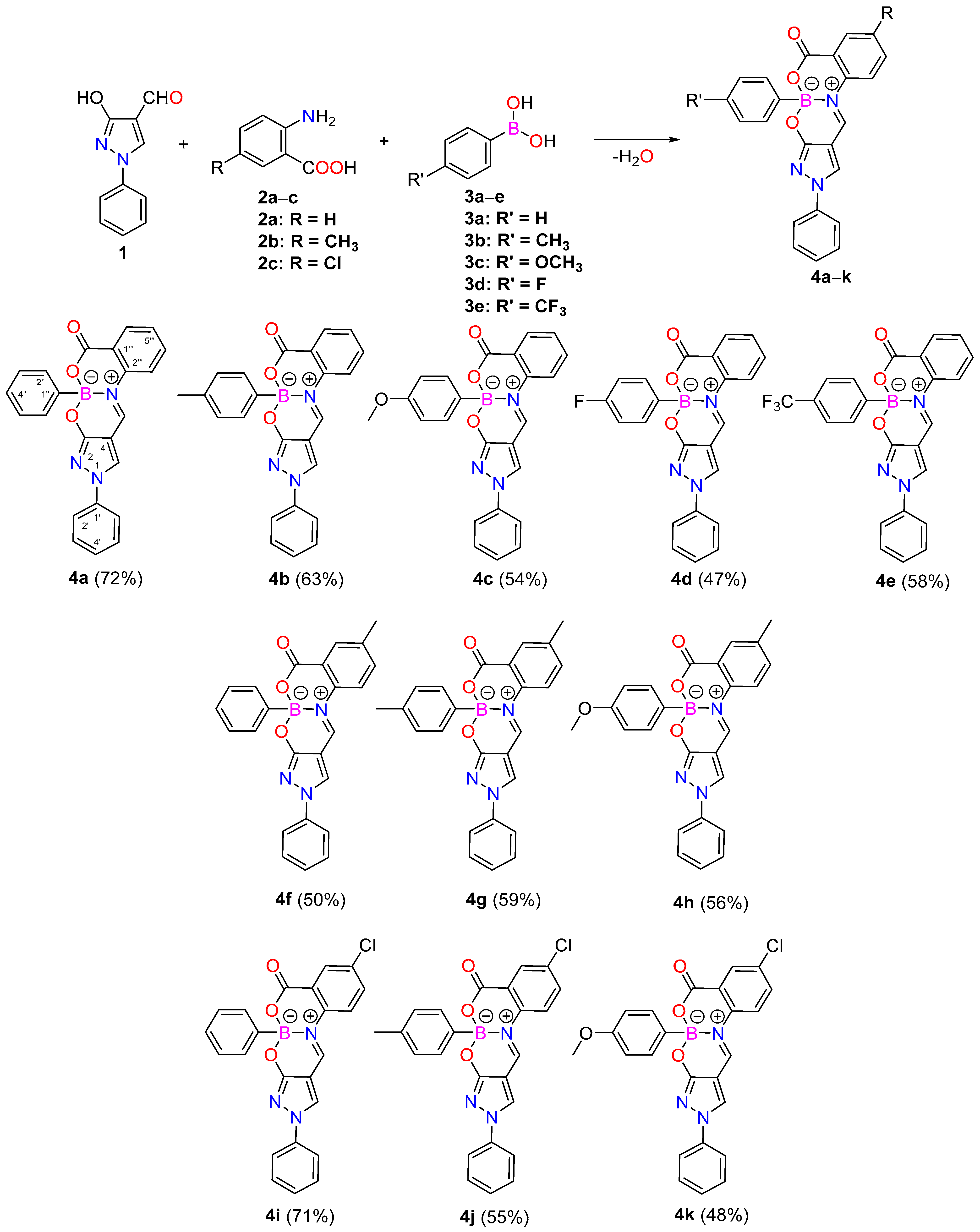
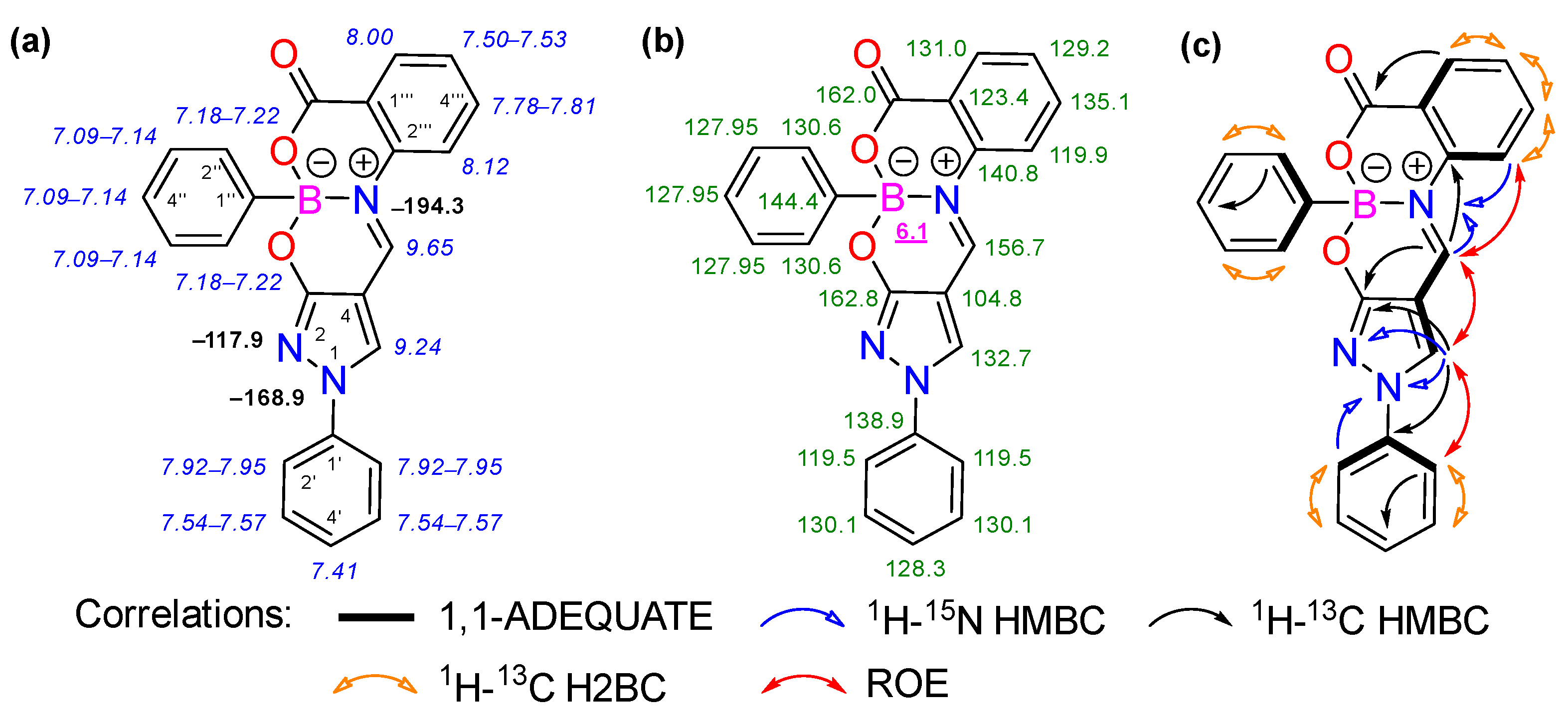
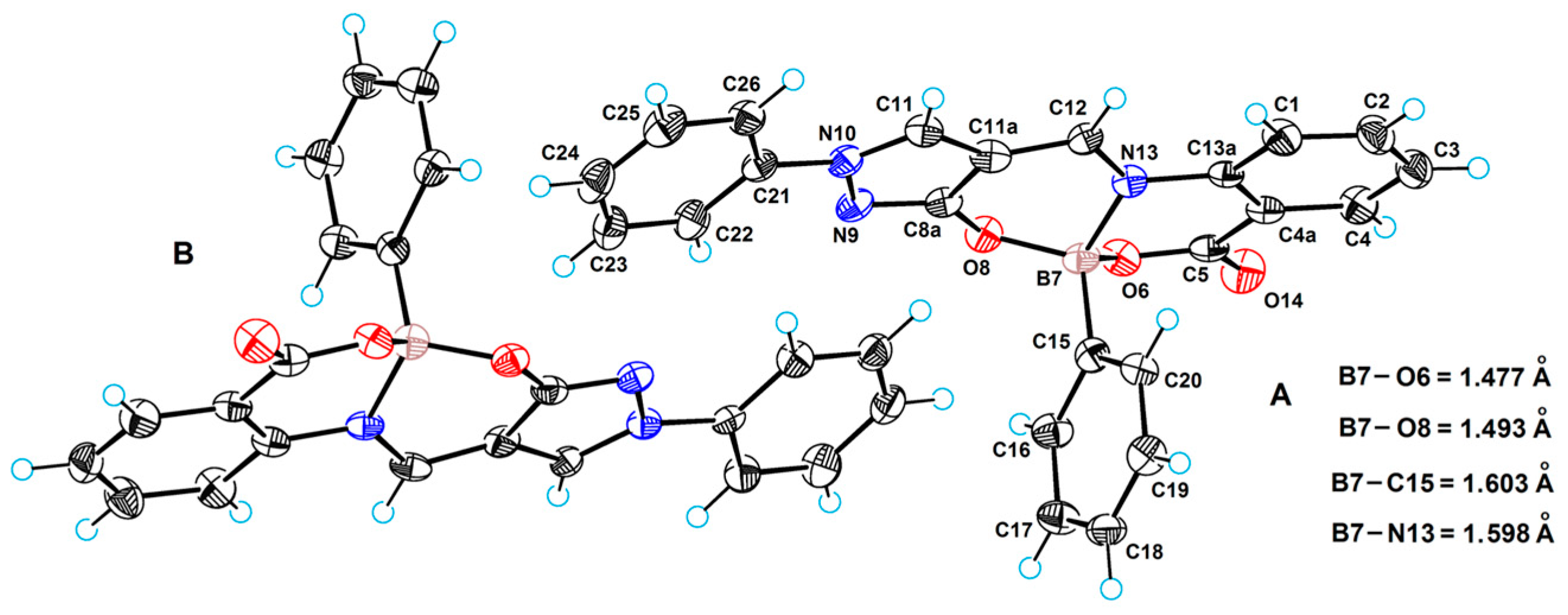
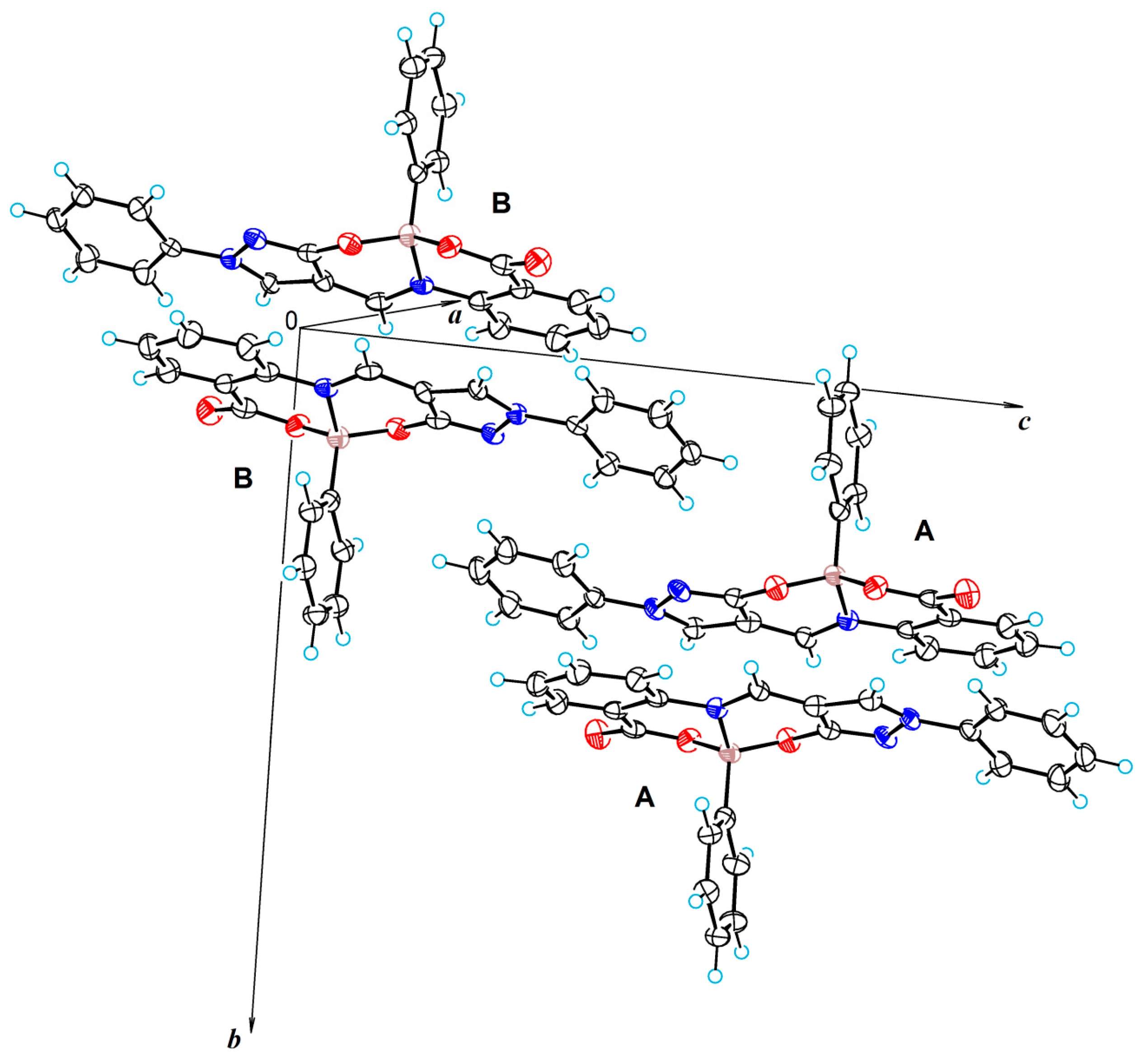
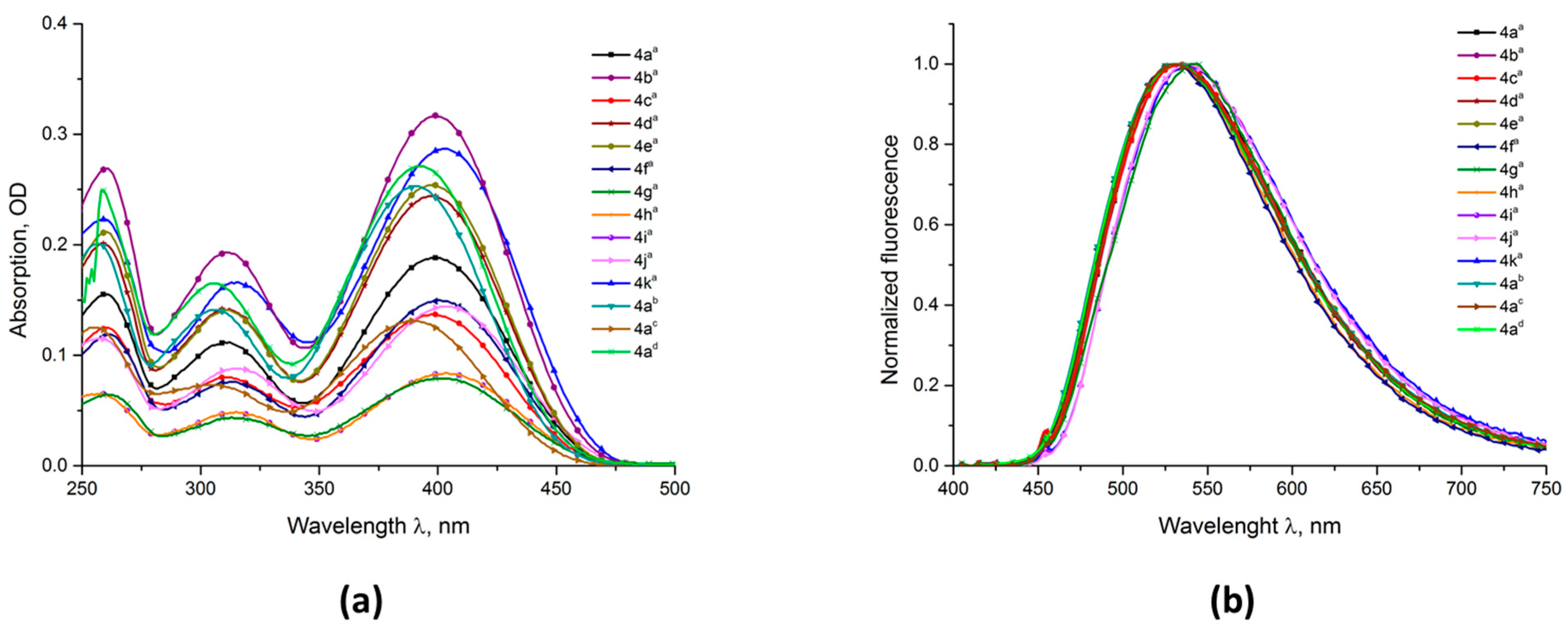
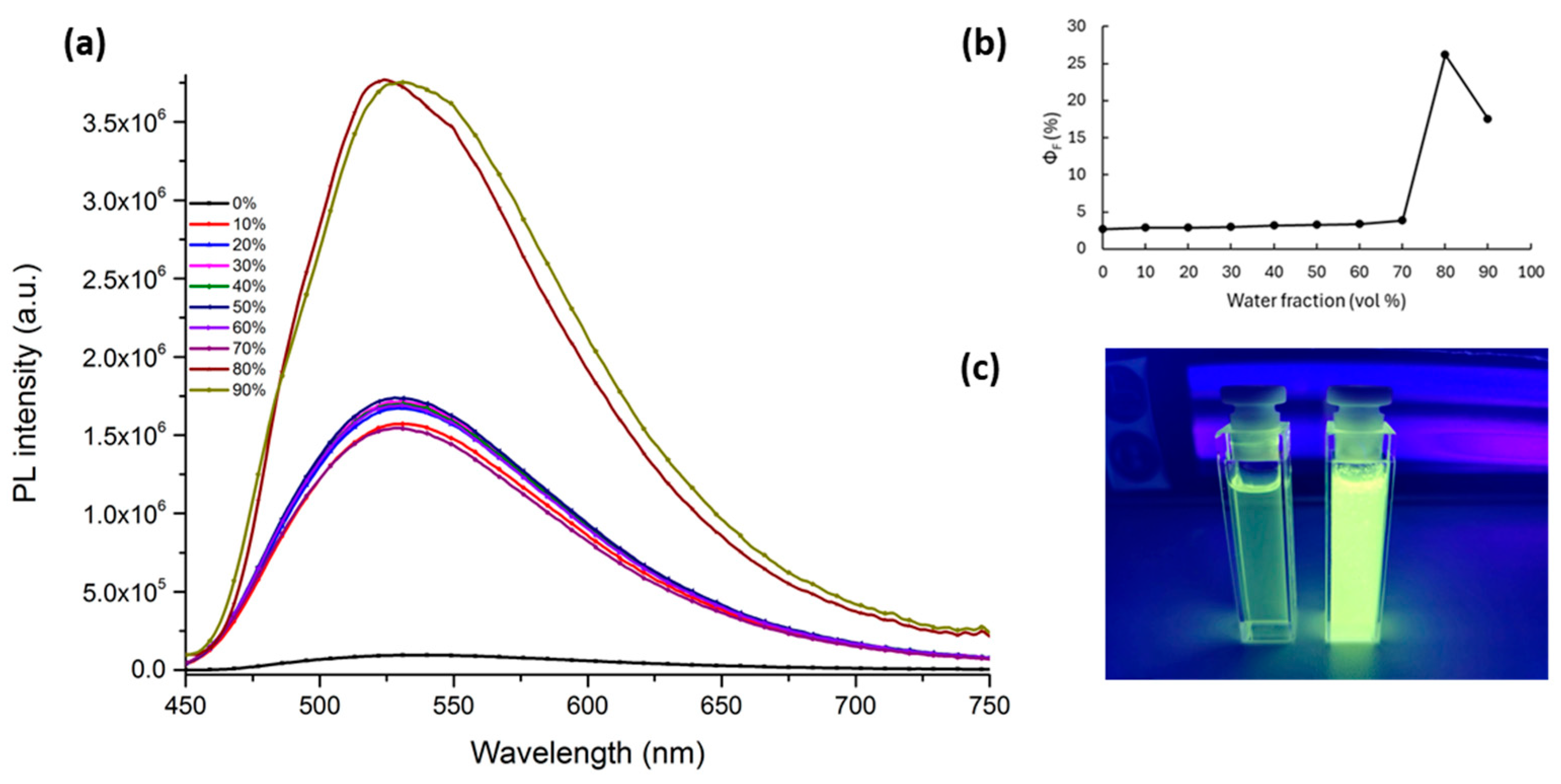
| Entry | Comp. | λabs (nm) | ε × 103 (dm3mol−1 cm−1) | λem (nm) | Stokes Shifts (nm) | Φf (%) | λem (nm) in H2O–THF (v/v %) | Φf (%) in H2O–THF (v/v %) |
|---|---|---|---|---|---|---|---|---|
| 1 | 4a a | 260 | 14.68 | 133 | 2.7 | 524 H2O/THF (80/20) | 26.2 H2O/THF (80/20) | |
| 310 | 10.61 | 533 | ||||||
| 400 | 17.80 | |||||||
| 2 | 4b a | 260 | 26.07 | 132 | 2.8 | 526 H2O/THF (70/30) | 18.8 H2O/THF (70/30) | |
| 311 | 30.14 | 531 | ||||||
| 399 | 30.72 | |||||||
| 3 | 4c a | 260 | 12.02 | 135 | 0.2 | 529 H2O/THF (90/10) | 11.9 H2O/THF (90/10) | |
| 309 | 7.69 | 533 | ||||||
| 398 | 13.17 | |||||||
| 4 | 4d a | 259 | 18.56 | 137 | 1.9 | 544 H2O/THF (80/20) | 25.4 H2O/THF (80/20) | |
| 312 | 13.12 | 534 | ||||||
| 397 | 22.54 | |||||||
| 5 | 4e a | 260 | 20.58 | 525 H2O/THF (80/20) | 30.6 H2O/THF (80/20) | |||
| 312 | 13.68 | 532 | 135 | 1.9 | ||||
| 397 | 24.65 | |||||||
| 6 | 4f a | 261 | 11.67 | 527 H2O/THF (80/20) | 15.1 H2O/THF (80/20) | |||
| 312 | 7.45 | 529 | 128 | 0.4 | ||||
| 401 | 14.71 | |||||||
| 7 | 4g a | 260 | 6.67 | 546 H2O/THF (80/20) | 52.2 H2O/THF (80/20) | |||
| 313 | 4.52 | 543 | 142 | 2.0 | ||||
| 401 | 8.11 | |||||||
| 8 | 4h a | 262 | 13.01 | 538 H2O/THF (80/20) | 29.2 H2O/THF (80/20) | |||
| 313 | 7.80 | 531 | 131 | 0.5 | ||||
| 400 | 15.00 | |||||||
| 9 | 4i a | 258 | 6.10 | 537 H2O/THF (80/20) | 7.0 H2O/THF (80/20) | |||
| 315 | 4.60 | 538 | 134 | 3.7 | ||||
| 404 | 7.88 | |||||||
| 10 | 4j a | 257 | 11.53 | 536 H2O/THF (80/20) | 24.4 H2O/THF (80/20) | |||
| 315 | 8.82 | 539 | 135 | 4.3 | ||||
| 404 | 14.43 | |||||||
| 11 | 4k a | 259 | 20.80 | 135 | 0.1 | 539 H2O/THF (80/20) | 19.8 H2O/THF (80/20) | |
| 315 | 15.48 | 538 | ||||||
| 403 | 26.77 | |||||||
| 12 | 4a b | 255 | 13.46 | |||||
| 305 | 7.86 | 531 | 141 | 1.6 | - | - | ||
| 390 | 14.10 | |||||||
| 13 | 4a c | 257 | 20.00 | |||||
| 306 | 14.03 | 531 | 140 | 3.1 | - | - | ||
| 391 | 25.17 | |||||||
| 14 | 4a d | 258 | 26.45 | |||||
| 305 | 17.53 | 531 | 138 | 1.5 | - | - | ||
| 393 | 28.78 |
Disclaimer/Publisher’s Note: The statements, opinions and data contained in all publications are solely those of the individual author(s) and contributor(s) and not of MDPI and/or the editor(s). MDPI and/or the editor(s) disclaim responsibility for any injury to people or property resulting from any ideas, methods, instructions or products referred to in the content. |
© 2024 by the authors. Licensee MDPI, Basel, Switzerland. This article is an open access article distributed under the terms and conditions of the Creative Commons Attribution (CC BY) license (https://creativecommons.org/licenses/by/4.0/).
Share and Cite
Savickienė, V.; Bieliauskas, A.; Belyakov, S.; Arbačiauskienė, E.; Šačkus, A. Multicomponent Synthesis of New Fluorescent Boron Complexes Derived from 3-Hydroxy-1-phenyl-1H-pyrazole-4-carbaldehyde. Molecules 2024, 29, 3432. https://doi.org/10.3390/molecules29143432
Savickienė V, Bieliauskas A, Belyakov S, Arbačiauskienė E, Šačkus A. Multicomponent Synthesis of New Fluorescent Boron Complexes Derived from 3-Hydroxy-1-phenyl-1H-pyrazole-4-carbaldehyde. Molecules. 2024; 29(14):3432. https://doi.org/10.3390/molecules29143432
Chicago/Turabian StyleSavickienė, Viktorija, Aurimas Bieliauskas, Sergey Belyakov, Eglė Arbačiauskienė, and Algirdas Šačkus. 2024. "Multicomponent Synthesis of New Fluorescent Boron Complexes Derived from 3-Hydroxy-1-phenyl-1H-pyrazole-4-carbaldehyde" Molecules 29, no. 14: 3432. https://doi.org/10.3390/molecules29143432
APA StyleSavickienė, V., Bieliauskas, A., Belyakov, S., Arbačiauskienė, E., & Šačkus, A. (2024). Multicomponent Synthesis of New Fluorescent Boron Complexes Derived from 3-Hydroxy-1-phenyl-1H-pyrazole-4-carbaldehyde. Molecules, 29(14), 3432. https://doi.org/10.3390/molecules29143432







